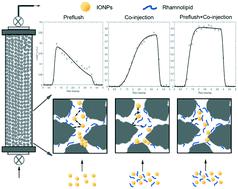当前位置:
X-MOL 学术
›
Environ. Sci.: Nano
›
论文详情
Our official English website, www.x-mol.net, welcomes your feedback! (Note: you will need to create a separate account there.)
Effect of rhamnolipid biosurfactant on transport and retention of iron oxide nanoparticles in water-saturated quartz sand
Environmental Science: Nano ( IF 7.3 ) Pub Date : 2020-12-18 , DOI: 10.1039/d0en01033b Shuchi Liao 1, 2, 3, 4 , Anushree Ghosh 4, 5, 6, 7, 8 , Matthew D. Becker 4, 9, 10, 11 , Linda M. Abriola 4, 9, 10, 11 , Natalie L. Cápiro 4, 9, 12, 13 , John D. Fortner 4, 8, 14, 15 , Kurt D. Pennell 1, 2, 3, 4
Environmental Science: Nano ( IF 7.3 ) Pub Date : 2020-12-18 , DOI: 10.1039/d0en01033b Shuchi Liao 1, 2, 3, 4 , Anushree Ghosh 4, 5, 6, 7, 8 , Matthew D. Becker 4, 9, 10, 11 , Linda M. Abriola 4, 9, 10, 11 , Natalie L. Cápiro 4, 9, 12, 13 , John D. Fortner 4, 8, 14, 15 , Kurt D. Pennell 1, 2, 3, 4
Affiliation

|
Although prior studies have investigated the effects of solution constituents, including dissolved organic matter and synthetic polymers, on nanoparticle mobility in porous media, far less attention has been directed toward evaluating the impacts of biosurfactants secreted by microorganisms on the transport and retention behavior of nanomaterials. The objective of this study was to explore the influence of rhamnolipid, a biosurfactant associated with biofilms, on the transport and retention of iron oxide nanoparticles (IONPs) in a water-saturated quartz sand. Column experiments were conducted using aerobic medium (ionic strength = 50.4 mM) or 10 mM NaCl as background electrolyte at a pore velocity of 0.43 m per day and pH 6.8 ± 0.2. In aerobic medium columns, nearly all introduced nanoparticles were retained when IONPs were injected alone, whereas the presence of 10 mg L−1 or 50 mg L−1 rhamnolipid resulted in ∼25% and ∼50% breakthrough of the injected IONP mass, respectively. Moreover, preflushing media with 50 mg L−1 rhamnolipid further increased IONP mass breakthrough by ∼30%. Similar enhancement of nanoparticle mobility by 50 mg L−1 rhamnolipid was also measured in lower ionic strength (10 mM NaCl) columns. Mathematical models that incorporated nanoparticle filter ripening and biosurfactant competitive adsorption successfully reproduced experimental observations. Modeling results predicted an order-of-magnitude decrease in IONP filter ripening rate coefficient and a three-fold drop in average IONP retention capacity in the presence of rhamnolipid, consistent with a stabilizing effect and competition for surface sites. These findings demonstrate that rhamnolipid biosurfactant can potentially enhance nanomaterial stability and mobility in subsurface environments and that these effects should be considered when evaluating the impact of biological process on nanoparticle fate and transport in porous media.
中文翻译:

鼠李糖脂生物表面活性剂对水饱和石英砂中氧化铁纳米颗粒迁移和保留的影响
尽管先前的研究已经研究了溶液成分(包括溶解的有机物和合成聚合物)对多孔介质中纳米颗粒迁移率的影响,但对评估微生物分泌的生物表面活性剂对纳米材料的迁移和保留行为的影响的关注却很少。这项研究的目的是探讨鼠李糖脂(一种与生物膜相关的生物表面活性剂)对水饱和石英砂中氧化铁纳米颗粒(IONPs)的运输和保留的影响。使用有氧介质(离子强度= 50.4 mM)或10 mM NaCl作为背景电解质,在每天0.43 m的孔速和pH 6.8±0.2的条件下进行柱实验。在有氧培养基色谱柱中,单独注入IONP时几乎保留了所有引入的纳米颗粒,-1或50 mg L -1鼠李糖脂分别导致所注入IONP物质的〜25%和〜50%穿透。此外,含有50 mg L -1鼠李糖脂的预冲洗介质使IONP的质量突破进一步提高了约30%。纳米粒子迁移率提高50 mg L -1鼠李糖脂也在较低的离子强度(10 mM NaCl)色谱柱中测量。结合纳米颗粒过滤器成熟和生物表面活性剂竞争性吸附的数学模型成功地再现了实验观察结果。建模结果预测,在鼠李糖脂存在的情况下,IONP过滤器的成熟速率系数将下降一个数量级,平均IONP保持能力将下降三倍,这与稳定作用和对表面位点的竞争相一致。这些发现表明鼠李糖脂生物表面活性剂可以潜在地增强纳米材料在地下环境中的稳定性和迁移性,并且在评估生物过程对纳米颗粒命运和在多孔介质中运输的影响时应考虑这些影响。
更新日期:2021-01-04
中文翻译:

鼠李糖脂生物表面活性剂对水饱和石英砂中氧化铁纳米颗粒迁移和保留的影响
尽管先前的研究已经研究了溶液成分(包括溶解的有机物和合成聚合物)对多孔介质中纳米颗粒迁移率的影响,但对评估微生物分泌的生物表面活性剂对纳米材料的迁移和保留行为的影响的关注却很少。这项研究的目的是探讨鼠李糖脂(一种与生物膜相关的生物表面活性剂)对水饱和石英砂中氧化铁纳米颗粒(IONPs)的运输和保留的影响。使用有氧介质(离子强度= 50.4 mM)或10 mM NaCl作为背景电解质,在每天0.43 m的孔速和pH 6.8±0.2的条件下进行柱实验。在有氧培养基色谱柱中,单独注入IONP时几乎保留了所有引入的纳米颗粒,-1或50 mg L -1鼠李糖脂分别导致所注入IONP物质的〜25%和〜50%穿透。此外,含有50 mg L -1鼠李糖脂的预冲洗介质使IONP的质量突破进一步提高了约30%。纳米粒子迁移率提高50 mg L -1鼠李糖脂也在较低的离子强度(10 mM NaCl)色谱柱中测量。结合纳米颗粒过滤器成熟和生物表面活性剂竞争性吸附的数学模型成功地再现了实验观察结果。建模结果预测,在鼠李糖脂存在的情况下,IONP过滤器的成熟速率系数将下降一个数量级,平均IONP保持能力将下降三倍,这与稳定作用和对表面位点的竞争相一致。这些发现表明鼠李糖脂生物表面活性剂可以潜在地增强纳米材料在地下环境中的稳定性和迁移性,并且在评估生物过程对纳米颗粒命运和在多孔介质中运输的影响时应考虑这些影响。



























 京公网安备 11010802027423号
京公网安备 11010802027423号